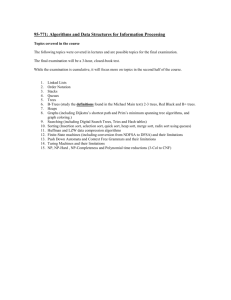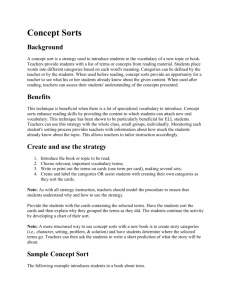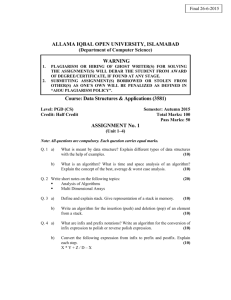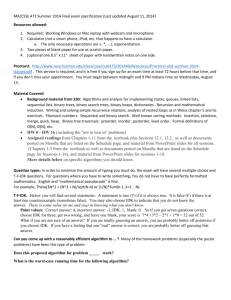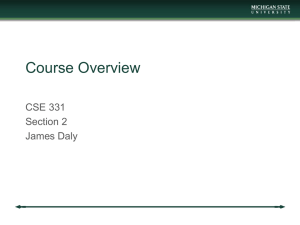Lecture Plan
advertisement
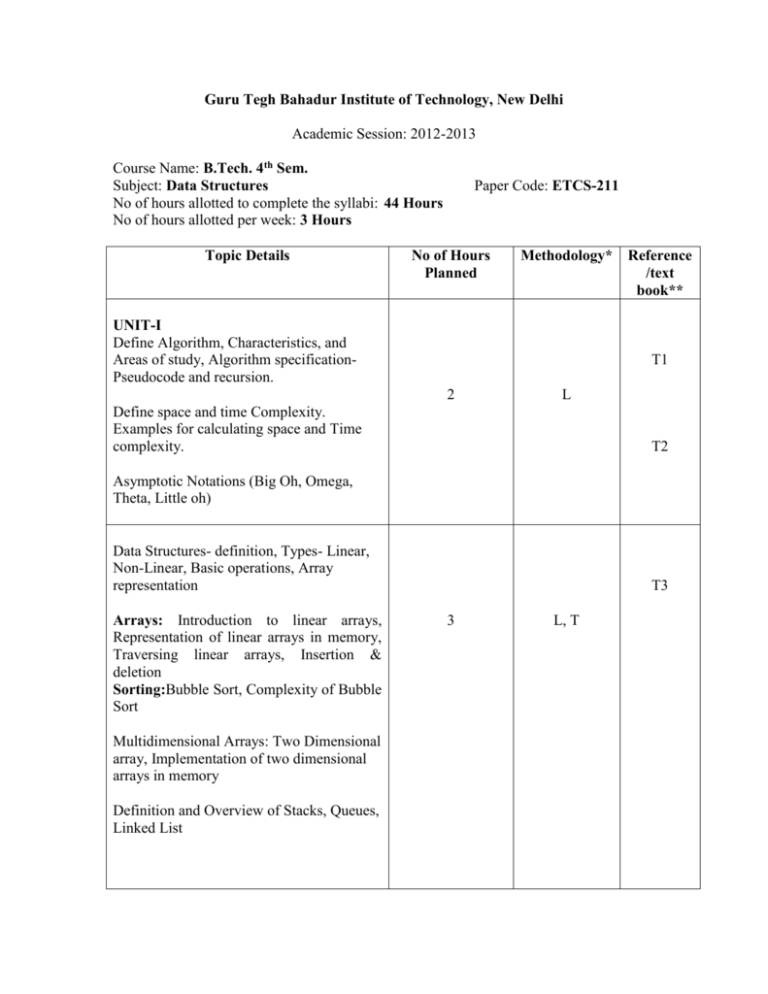
Guru Tegh Bahadur Institute of Technology, New Delhi Academic Session: 2012-2013 Course Name: B.Tech. 4th Sem. Subject: Data Structures No of hours allotted to complete the syllabi: 44 Hours No of hours allotted per week: 3 Hours Topic Details Paper Code: ETCS-211 No of Hours Planned Methodology* UNIT-I Define Algorithm, Characteristics, and Areas of study, Algorithm specificationPseudocode and recursion. Reference /text book** T1 2 L Define space and time Complexity. Examples for calculating space and Time complexity. T2 Asymptotic Notations (Big Oh, Omega, Theta, Little oh) Data Structures- definition, Types- Linear, Non-Linear, Basic operations, Array representation Arrays: Introduction to linear arrays, Representation of linear arrays in memory, Traversing linear arrays, Insertion & deletion Sorting:Bubble Sort, Complexity of Bubble Sort Multidimensional Arrays: Two Dimensional array, Implementation of two dimensional arrays in memory Definition and Overview of Stacks, Queues, Linked List T3 3 L, T Linked List- Representation in memory, Dynamic allocation, Creation of a Linked List Algorithm – creation, traversing, Counting elements and Searching in a linked list. 3 L T4 Memory allocation, Garbage Collection, Avail List. Algorithm for sorting elements in a linked list. Algorithm for inserting and deleting elements from a linked list from first last and middle position Doubly Linked List- Algorithm for creation, Traversal (Forward/ Backward), Insertion and deletion Header List (Circular & Grounded) Algorithm for creation, insertion, traversal and deletion. T4 4 L Polynomial arithmetic- Algorithm for Polynomial addition using circular Linked list Generalized Lists. Sparse Matrices- Creation, Addition, Transpose and Multiplication algorithms. Equivalence Relations. T7 Stacks-Implementation using Arrays & Linked List. Algorithm for PUSH & POP operations Evaluation of Postfix expression, 4 Conversion for infix to postfix expression and their algorithms. Queues- Implementation using Array and L, T T4 Linked List and Algorithms for insertion deletion from the queue using above implementations. Circular queue- implementation using arrays & Linked List. Priority queues, Dqueues, Multiple Stacks and Queues UNIT-II Searching- Linear Search, Binary Search & their complexity Trees: Overview of Trees—Terminology, Definitions, Binary tree, Complete, full and strictly binary tree. Tree Traversals (preorder, postorder and preorder), Representation of Arithmetic expression as a binary tree. Formation of Binary tree from given Inorder and preorder/ postorder traversals. 3 L, A T4, T10 L, T T4, T5 2 Non-recursive and Recursive algorithms for preorder, Inorder, Postorder traversal. First Term Exam Threaded binary trees. Binary Search Tree—Build, Search an element, Insertion (Algorithms) Algorithm for deletion of a node in a BST having no child, one child and two children. 2 Heap—Build a heap, insertion and deletion from a heap 3 Balanced Trees—AVL trees, Build an AVL tree and Insertion (Rebalancing), AVL trees—Deletion and Rebalancing Multiway Search trees: B-Tree—Build, Insertion (splitting), Deletion (concatenation), B+ tree, B* tree 2 L, A T5, T7 3 L T4, T7 Application of trees—Set representations, Game trees, Decision trees UNIT-III Graphs, Digraphs and associated terminology (Path, degree, Connected, Isolated, Cycle, depth etc.) Representation of graphs- Sequential & Linked (Adjacency Matrix, Path matrix, Adjacency List) Graph traversals- Breadth first search, Depth First Search Connected components, Transitive closure, Topological Sort Spanning Tree, Minimum cost spanning tree, Kruskal’s and Prim’s Algorithm 4 T4, T7, T8, T9 L Shortest path- Dijkstra’s Algorithm & Implementation and Floyd Warshall algorithm Activity Network, Critical Path Sorting—Internal (Selection sort, Bubble sort, Insertion sort, Radix sort, Merge Sort, Shell sort, Heap sort, Quick sort) & their complexity Second Class Test UNIT-IV Differences between External and Internal searching/ Sorting. 2 0 2 External Sorting-(K-way Mergesort, Balanced and PolyPhase MergeSort) L T10, T11 UNIT-IV Files, Queries and Sequential organization. Cylinder Surface Indexing, Tree Indexing, Trie Indexing 3 L,A T4, T7 Random File Organization- Direct Addressing, Directory Lookup, Hashing Linked Organization, Inverted files, Cellular Partitions Revision and Discuss last year Question Papers 2 *Methodology Used: L-Lecture, T-Tutorial, A-Assignment **Text Books/ Reference Books: T1- Fundamentals of Computer Algorithms……. S. Sahni …Galgotia Publications T2- Fundamentals of Data Structures using C++.. S. Sahni …Galgotia Publications T3- Expert Data Structures with C………………. R.B.Patel…Khanna Publications T4-Theory & Problems of Data Structures……… Seymour……..TMH T5- Data Structures & Program Design………….. R.L.Kruse……PHI T6- Data Structures using C & C++……………… Tanenbaum……PHI T7- Fundamentals of Data Structures……………. S. Sahni … Galgotia Publications (2003 Reprint) T8-Data Structures, Algo’s & applications in C++. S. Sahni……McGraw Hill T9-Graph Theory with applications to CS……… N. Deo…….PHI T10An Intro. to Data Structures with Applications…Tremblay….McGraw Hill T11File Structures- an OO approach with C++…….M. J. Folk….Pearson Edu.
